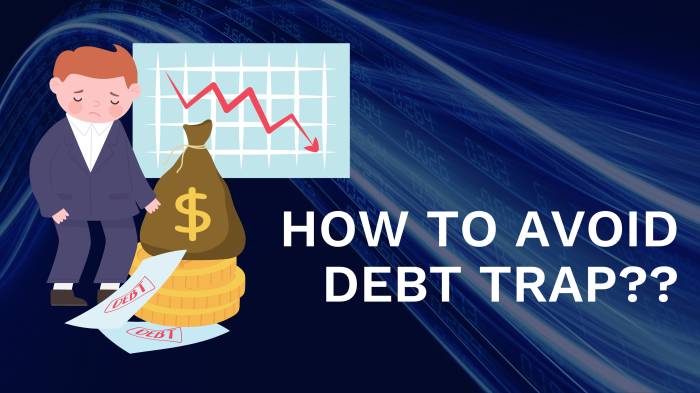Diving into the world of avoiding debt traps, this introduction sets the stage for a journey through financial responsibility and savvy planning, all while keeping it real with an American high school hip vibe.
Get ready to explore the ins and outs of staying financially secure and dodging those pesky debt traps that can sneak up on anyone.
Understanding Debt Traps
Debt traps are situations where individuals find themselves in a cycle of borrowing and struggling to repay their debts, often leading to financial distress and long-term consequences.
Common warning signs that indicate you might be falling into a debt trap include relying on credit cards to cover basic expenses, making only minimum payments on debts, borrowing money to pay off existing debts, and constantly feeling overwhelmed by financial obligations.
Types of Debt Traps
- Payday Loans: Short-term, high-interest loans that often target low-income individuals, trapping them in a cycle of borrowing to cover expenses.
- Credit Card Debt: Accumulating high balances on credit cards and only making minimum payments can lead to a never-ending cycle of debt with high-interest rates.
- Car Title Loans: Borrowing money using a vehicle as collateral can result in losing the vehicle if payments are not made, leading to a loss of an essential asset.
- Debt Consolidation Scams: Some companies promise to consolidate debts into one low monthly payment but end up charging high fees and not actually reducing the debt burden.
Budgeting and Financial Planning
Creating a realistic budget is crucial in avoiding overspending and falling into debt traps. By setting financial goals and tracking expenses effectively, you can manage your finances wisely.
Tips for Creating a Realistic Budget
- Calculate your monthly income after taxes.
- List all your expenses, including fixed costs like rent and utilities, as well as variable expenses like groceries and entertainment.
- Differentiate between needs and wants to prioritize essential spending.
- Allocate a portion of your income for savings and emergency funds.
Importance of Setting Financial Goals
Setting financial goals provides a roadmap for your financial future, helping you stay focused and motivated to avoid unnecessary spending.
Strategies for Tracking Expenses
- Use budgeting apps or spreadsheets to monitor your spending habits.
- Review your expenses regularly to identify areas where you can cut back.
- Consider using cash envelopes for specific categories to limit overspending.
Managing Debt Responsibly

To manage debt responsibly, it’s crucial to understand the difference between good debt and bad debt. Good debt is typically used to invest in something that will increase in value over time, like a home or education. On the other hand, bad debt is incurred for purchases that do not hold or increase in value, like credit card debt from unnecessary expenses.
Prioritizing Debt Repayment
- Start by making a list of all your debts, including the total amount owed and the interest rates.
- Focus on paying off high-interest debts first to prevent them from growing larger over time.
- Consider using the debt snowball method, where you pay off the smallest debt first and then move on to the next one.
- Avoid taking on new debt while you are working on paying off your existing debts.
Negotiating with Creditors
- Contact your creditors to discuss your situation and see if they are willing to lower your interest rates or create a more manageable repayment plan.
- Be honest about your financial struggles and provide any documentation they may require to support your case.
- Consider working with a credit counseling agency to help negotiate with creditors on your behalf and create a debt management plan.
Building Emergency Savings
Having an emergency fund is crucial in avoiding debt traps, as it provides a safety net during unexpected financial hardships. It allows you to cover expenses without relying on credit cards or loans, preventing you from accumulating debt.
Starting Your Emergency Fund
- Set a specific savings goal: Determine how much you want to save for emergencies, such as 3 to 6 months’ worth of living expenses.
- Automate your savings: Set up automatic transfers from your checking account to a separate savings account dedicated to emergencies.
- Cut back on non-essential expenses: Identify areas where you can reduce spending to free up money for your emergency fund.
Benefits of Having an Emergency Fund
- Peace of mind: Knowing you have savings set aside for emergencies can reduce stress and anxiety about unexpected financial challenges.
- Avoiding debt: Having a financial safety net allows you to cover unexpected expenses without resorting to borrowing money.
- Financial stability: An emergency fund provides stability and security in times of uncertainty, helping you stay on track with your financial goals.